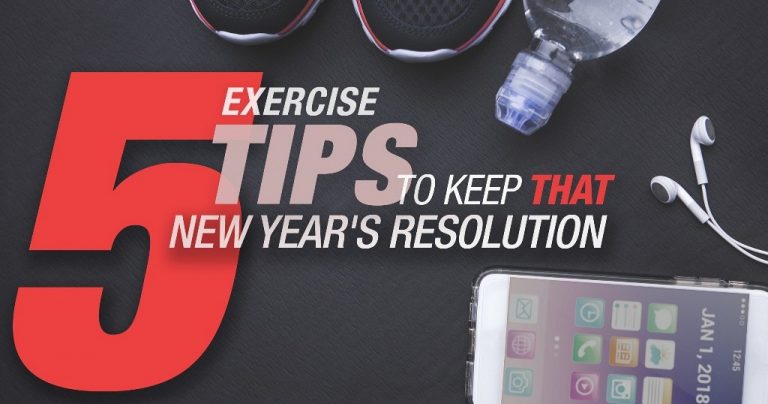
5 Exercise Tips to Keep That New Year’s Resolution
Make no mistake about it – we are fully entrenched in the Holiday Season. Next up after all the shopping, meal preparation, stress, and overeating, comes the dreaded New Year’s Resolution. The most common resolution, of course, is to exercise, lose weight or get in shape. “This is the year!” Sound familiar? As an avid exercise enthusiast, I’ve seen the gym-goers in January which start to dwindle in number by March or February usually. Many people fizzle out of their exercise commitment for one reason or another. An unfortunate culprit of exercise drop-outs is injuries. While the motivation to recommit oneself to a lifestyle of healthy eating and exercise is admirable, it is can also be risky.
Follow these 5 exercise tips to avoid injury at the gym and keep working on those New Year’s fitness goals:
1. Fitness vs. Health
There’s a difference between working out for fitness and working out for health. Most people work out for fitness because it’s a lot more fun than working on some of the key exercises we PTs use for restoring a person to musculoskeletal health. However, it’s vital to know the difference and to know that while many fitness exercise programs like CrossFit or Boot Camps are attractive because people can quickly “feel the burn,” these one-size-fits-all programs may easily cause more harm to our joints, muscles, and tendons than they offer benefit. As most of us resolution-ers are in a middle-age-give-or-take age bracket, this is especially important. At 18 years old, we can only work out for fitness because at that point we usually 10-feet tall and bullet-proof. But as the years go by and the tires get more miles on them, we need to be more mindful of that and focus equally on exercising for our health as we do for our fitness.
2. Stretch
Easier said than done. But many of us are sedentary and seated most of the day, so we all need to focus stretching our shoulders, necks, low back, hips, knees, and ankle to improve or maintain the available range of motion we have in them to move and live in. The truth is, most injuries can be avoided by stretching our joints and muscles to maintain our freedom of movement.
3. Work in a pain-free range of motion
This may seem like a no-brainer, but it’s an important one. It also relies on your ability to know your limits and to know the difference between pain, soreness, and fatigue. Regardless of what your friend, or personal trainer, or person from the Youtube video may tell you about a certain exercise, know your body and know when and how to modify an exercise to make sure it can be done pain-free.
4. Bench-press? Think again
Follow this guide for the safest chest and shoulder exercise. A prime example of my point in item #1 is the bench press. Sadly, it’s become the most popular male weightlifting exercise, mostly stemming from high school. Walk into any gym in America, and you’ll see why I’ve dubbed every Monday as “National Bench Press Day.” The bench is one of the worst exercises we can do for the health of our shoulders. It’s an exercise we can get away with in high school, but in our 30s and 40s, as our rotator cuff can accumulate more wear-and-tear, it’s not something we so easily tolerate. Same goes for the military press.
Here is my list of safest-to-least-safe basic gym chest/shoulder weight training exercises:
- (Most Safe) Push-ups: There’s no shortage of variation and progressions
- Incline bench with dumbbells
- Incline bench with barbell
- Flat bench with dumbbells
- Military press with barbell (in front of head)
- Flat bench with barbell
- (Least Safe) Military press with barbell (behind head)
5. Walk. Walk. Walk.
Find time to walk every day. The last tip is to make time to walk at least 20 continuous minutes every day. The health benefits of regular daily walking are too high to list on this page. I consider this daily walking as one of the examples of exercising for health. It’s paramount to find or make the time to make this regular because not only does it perfectly compliment the exercises for fitness we do, but it’s easier to stick with consistently and see regular health benefits from it as a result.
Here’s the point…
Follow these simple guidelines and don’t let an injury keep you from your fitness or health goals next year. If you want to start by just walking or running, check out our article on taking your first steps. It’s important to listen to your body. If you feel an injury starting to arise consult with one of the Physical Therapists and exercise specialists at your nearest Ivy Rehab for evaluation and/or treatment. Most of our states of service allow direct access, meaning you can see a PT without a prescription.
We’re always here to help. See you in 2018!
Matt Lesniak PT, DPT
Ivy Rehab Director of Outcomes and Clinical Programs
The medical information contained herein is provided as an information resource only, and does not substitute professional medical advice or consultation with healthcare professionals. This information is not intended to be patient education, does not create any patient-provider relationship, and should not be used as a substitute for professional diagnosis, treatment or medical advice. Please consult with your healthcare provider before making any healthcare decisions or for guidance about a specific medical condition. If you think you have a medical emergency, call your doctor or 911 immediately. IvyRehab Network, Inc. disclaims any and all responsibility, and shall have no liability, for any damages, loss, injury or liability whatsoever suffered as a result of your reliance on the information contained herein.